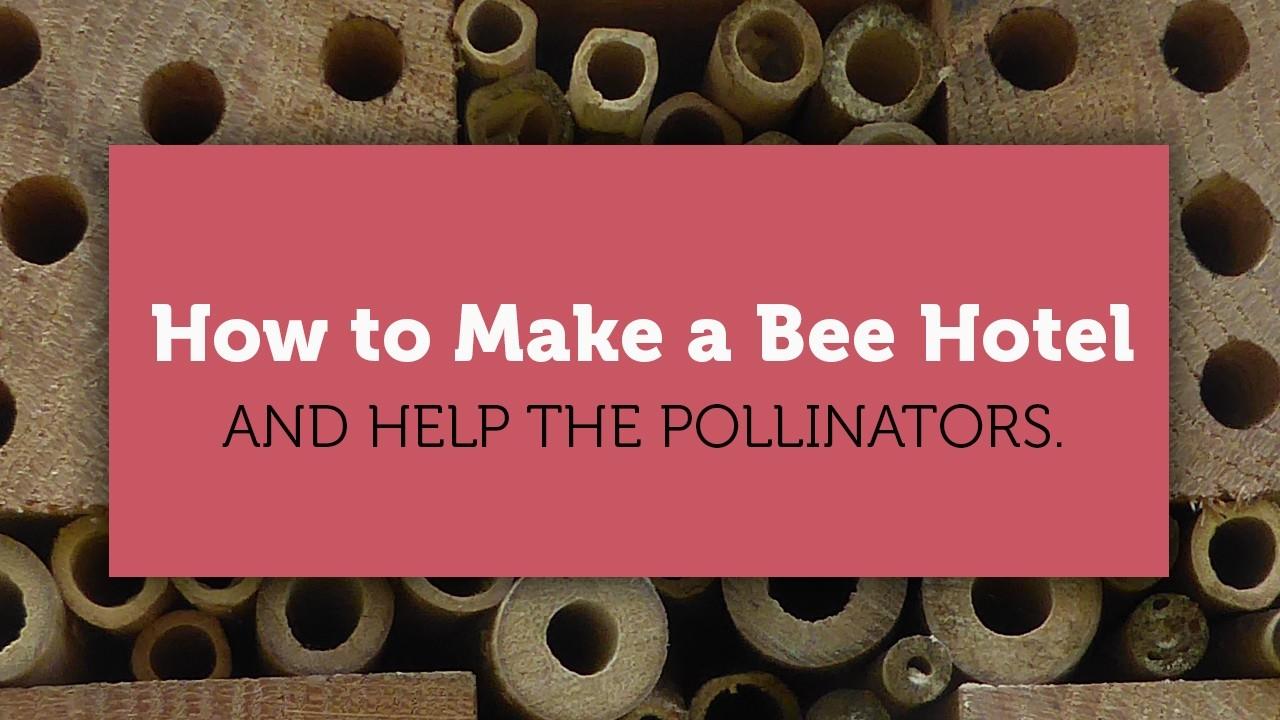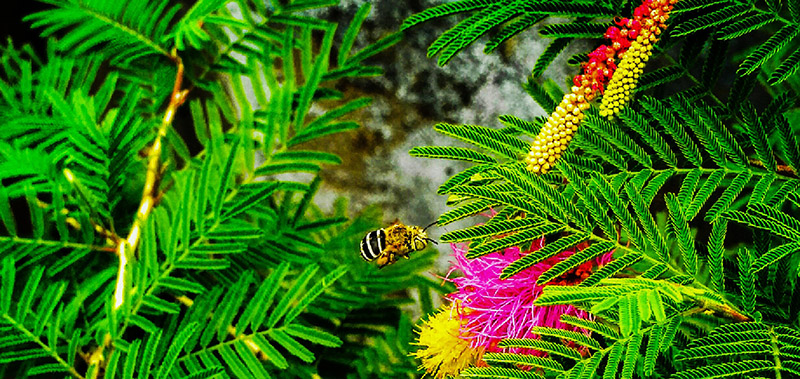
Easy Bee Hotel to Make for Your Garden
Sep 10, 2020A lot of articles and news stories talk about the collapse of the honey bee population and how important it is to help them, but really, it’s all pollinators that need our help.
There are over 19,000 different kinds of bees and 30% of them live in a tunnel or cavity. You can help these tunnel-nesting pollinators out by providing a place for them to call home. I'm not sure where the name came from, but kids these days are calling it a bee hotel.
Making a bee hotel is a fancy way of saying you're collecting hollow tubes, putting them somewhere and leaving them alone all Spring and Summer. Some tunnel-nesting bees that might visit your hotel are leaf cutters, mason bees, yellow-faced bees and carpenter bees. However, leaf cutters and mason bees are the most common bees those of you in the U.S. will see at your "hotel".
Learn more ways to help the bees
Enroll in our online class, Intro to Beekeeping. You'll learn how to plant flowers for bees, all about the hive and other ways you can help the bee population.

Steps to making a bee hotel
Even though a bee hotel is pretty simple in construction, there are some important measurements and things to consider.
Here are the steps to making a bee hotel for tunnel nesting bees.
- Gather a bundle of bamboo and/or plant stems that are 5-8” long and 1/16”-1/2” in diameter. You can also take a block of hard wood (non pressure treated) and drill holes into it. You want one end to be open and the other end to be closed. If you use bamboo, cut it after the node, because that is where the bamboo is not hollow.
- Put the blocks or bamboo into a container. This can be a flower pot on its side, plastic tub or bucket, a crate, in a cinder block or you can build a box. See below for a few ideas.
- Attach to a post or nail it to a tree. Ideally, it would be at least 4’ or taller, have a cover over the top to protect the tubes from sun and rain and face the morning sun.
Some bee hotel inspiration


I chose the designs above because I wanted you to see how simple they can be. It can be on a post, nailed to a tree or dangling from a string. The tunnels can be drilled into wood, or stacks of bamboo sticks in a box, can or pipe. The main photo at the top of this blog is my hotel. My husband made it for me for my birthday one year.
A few tips
Don’t be disappointed if bees don’t move into your hotel immediately. Sometimes it takes a few months for the wood to weather before bees move in.
Plant flowers that attract leaf cutters and mason bees and your hotel will have more visitors. Bees can only move into your hotel if there are bees nearby! See below for some recommendations.
You can buy bees. If you're not seeing bees move into your hotel or visiting the plants in your garden that they like, you can buy mason and leaf cutters. There are bee farms that sell solitary bees.
Attracting Leaf Cutter Bees

Leaf cutters need food (nectar and pollen) and materials to build their nest. These don't necessarily come from the same plants.
I've found that leaf cutters LOVE to use the bougainvillea leaves for their nests. Other plants that provide building material for leaf cutters are lilac, black-eyed susan vine, clematis, roses and clarkia. An easy way to tell if you already have leaf cutters in your garden is to look for half circles cut out of leaves. This is a giveaway that the leaf cutter was here. Don't worry, it doesn't harm the plant and is hardly noticeable.

Leaf cutters also need food. They will forage from blue bells, dahlias, sunflowers and most flowers that also attract honey bees. They are important pollinators of blueberries, onions, carrots and alfalfa, but will visit most herbs and veggies in your garden.
Some facts about leaf cutters
- Most active in the summer
- Pollinate a lot of fruits and vegetables
- Tunnel nesting
- Calm and docile
- Can sting but it is very rare
Attracting Mason Bees
Mason bees also need food (nectar and pollen) and materials to build their nest.
Mason bees do not gather leaves for their nest. They place their egg on a bed of pollen and separate the chambers for each egg with a mud wall. There's not much you can do to help them in their nest preparation other than creating your bee hotel. However, some people go that extra mile and create a mud source. You can do this by digging a hole, lining it with a waterproof material and putting the soil back in along with some water (If you have trouble with this, ask a small child for help. They're mud experts.). People who keep a lot of mason bees sometimes buy a mud mix for their bees. If you live somewhere that's rainy, this shouldn't be necessary but if you are in a dry area, you may want to provide the bees with some moist soil.
Mason bees are similar in size to honey bees and forage from similar plants that honey bees do, but they love the pollen from fruit trees for their babies and native plants will attract the mason bee species native to your area.
A few facts about mason bees
- Most active in spring
- Pollinate a lot of fruits and vegetables
- Tunnel nesting
- Calm and docile
- Can sting but is very rare
Maintain your hotel. This is very important!
You want to make sure you’re giving the bees a healthy place to live and prevent the growth of diseases or harboring pests.
The ideal way to tackle this is by having two bee hotels. I know this isn’t ideal, but trust me on this. You want to be able to clean out or replace the tubes every year. Otherwise, diseases can start to grow in them and you'll be doing more harm than good.
Since the bees overwinter in the nesting tunnels, the hotel you put out in early Spring will be in use until next Spring. Once winter is almost over, put out the second hotel. This will be where the bees make their new home after they hatch in the spring.
Once all of the bees have hatched from your first hotel, take it away. Clean the tubes at the end of the Summer and use them next year. You can do this by taking a pipe cleaner and making sure there’s no debris stuck in there or ants living inside. If it’s a wood block, pour a bleach water solution (1/2 cup bleach with gallon of water) over the block, rinse and dry. Leave to air out until next spring. It’s best to do this in the fall or winter so it’s ready for next spring. Don’t do this in the spring for next spring because insects could get to it when it’s warm out.
Replace all wood blocks and tubes every 2 years.
Monitoring in the warmer months
It’s easy to forget about your bee hotel, but its important to check on it monthly during the spring and summer.
Check for the following:
• Moisture getting into the nest box (attach a roof over the hotel or if no bees have moved in yet, move to a more protected location)
• Ant infestations (They are attracted to the pollen and bee larvae. This can be prevented by using sticky spray or ant bait at the base of the bee hotel.)
• Paper wasp nests
• Spider webs (often a sign that the nest location is too dark)
• Birds attacking the nest. If this happens, you can place a wire screen in front of the nest. Just make sure the holes are large enough for bees to get through and that the screen isn't blocking any of the tunnels that bees have already created a nest in.
Who will visit your hotel?
 Most likely, if you're in North America, you have mason or leaf cutters bees nearby. However, you can do a little extra research and figure out what bees are native to your area and create a habitat for them. Xerces.org is a great place to start.
Most likely, if you're in North America, you have mason or leaf cutters bees nearby. However, you can do a little extra research and figure out what bees are native to your area and create a habitat for them. Xerces.org is a great place to start.
Here in Hawaii, we have the yellow-faced bee. This is a small bee that sometimes uses coral and lava rock for their nest, so I added some of those to my bee hotel.
Why make a bee hotel?
Leaf cutters and mason bees are similar in size to honey bees are also excellent pollinators. Honey bees get most of the credit for pollination, but a lot of plants depend on pollination from non honey bees. Honey bees are used by farmers because they can reorientate themselves if their hive is moved. Most bees cannot do this. This allows the beekeeper to put hives on a farm for just a few months, when a crop is blooming, and move them when the bloom is over. This is necessary on mono crop farms because they are food deserts when their one crop is not blooming.
Bee hotels versus keeping honey bees
Of course, I'm a fan of keeping honey bees. I love spending time with my hives and getting to know them. Their hive structure fascinates me. I love watching them work and am amazed that tens of thousands of bees all work together, in what looks like perfect unison, to run a hive.
That being said, beekeeping is work. There's equipment to buy, lots to learn, and you have to inspect them weekly (except for when its cold out). If you're looking for pollination help, insect hotels are a great option, especially if you have a variety of plants that bloom throughout the spring, summer and fall.
Another benefit to insect hotels is that you can help the pollinators without spending a lot of money or time.
Insect hotels are a great way to get your kids interested in nature and the garden, without worrying about getting stung and needing suits. Most kids around the age of 8 LOVE learning about bugs.
The downside to insect hotels is that you don't open them up and you don't spend time with them (though you can hang out by them and watch the bees come and go). Most importantly, you don't get any honey from them!
More bee facts
- 90% of bees don't live in a hive
- 70% of bees live under ground
- 30% of bees live in holes or cavities
- There are at least 1,000 different kinds of hole-nesting bees in North America
Learn more
Want to learn more about beekeeping?
Join our newsletter for blog updates, beekeeping videos, sales and contests.



